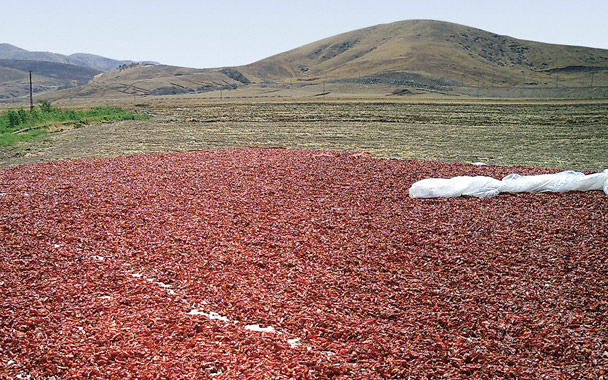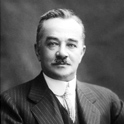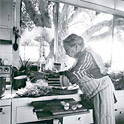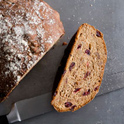It’s dusk in Şanlıurfa, 30 miles from the Syrian border in south-central Turkey. From our hotel terrace, we watch birds glide through the apricot-gold light that slants onto the building below, a shrine to the birthplace of Abraham. The first notes of the call to prayer float up to us, a single voice becoming a syncopated cacophony as a dozen muezzins from other mosques join in. This moment, I think, is why I love Turkey. Okay, maybe this moment and the food. In fact, I could swear I detect on the breeze the slightly harsh, sweetly vegetal aroma of the peppers that brought me here.
These are not just any peppers. They are, you might say, an obsession. And obsessions are unpredictable. Sometimes one springs full-blown into your consciousness; at other times, it grows slowly, almost unnoticed, until a friend says to you, “Do you have to put those Turkish peppers on everything?”
Well, just about.
In every café and kebab joint in Turkey, you will find Urfa and Maras, two dried, flaked red chile peppers, set out on the table. Urfa, named for the city, now called Şanlıurfa, near which it is grown, is a deep oxblood red, with an earthy, rather smoky flavor that contains, oddly, an echo of tobacco. Cherry-red Maras, which takes its name from the nearby town of Kahramanmaraş, has a brighter flavor, brash and fruity but with a very faint edge of bitterness. With both, the complex initial taste is followed by a mild, slow-building heat that lingers tantalizingly in the mouth. Added to a dish, these peppers deepen and broaden all the other flavors. Leave them out, and the food seems somehow flatter.
Over the course of several visits to Istanbul and coastal Turkey, I had become addicted. Back home, I found myself tossing the peppers into stews, rubbing them onto chops before putting them on the grill, and generally making them part of my daily cooking routine. A little pinch of Maras in that vinaigrette? Sure. A sprinkling of Urfa on the poached eggs? Why not?
After a while, though, even that wasn’t enough. As with artisanal products from all over the world, these peppers taste of the sun, air, and soil where they were grown. What is it, I wondered, about that place that gives them their unique character? I wanted to get to know the culinary equivalent of the peppers’ families. I needed to go to the source.
“We live always with this pepper; it is the constant in our lives,” says Ömer Aksoy, a representative of pepper producer Harran İsot, plucking a perfectly red Urfa from a low-growing plant. “The first batch we pick green and eat raw; the last ones, just before the rains begin, are the hottest—those are for flavoring.” In the morning, he explains, young children will clean a couple of peppers, take them to the fırın (communal oven), put them on the side to roast, then bring them home and eat them for breakfast, slathered with butter. But his personal favorite way to eat the fresh peppers is in a condiment called salça, which he translates as “pepper marmalade.” A classic folk product, it’s made differently in each region. Although there are mass-produced versions in some places, here it is made by hand, exactly the way it has been made for centuries, and only for use in the home. The villagers, he explains, like to spread it on bread and sprinkle it with ground hazelnuts or walnuts as a snack, or top it with a couple of fresh eggs for breakfast.
Sounds good to me. “Can we get ahold of some?” I ask. After a quick cellphone call, he says, “They will be making it today in Yaylak, a village not far from here. Let’s go.”
Driving to the village through the barren landscape of the Bozova Valley, we stop to watch Urfa peppers being harvested in a small field. Because they ripen at different rates, there are three or four separate pickings each season, which means the process cannot be mechanized—or at least, no machine has yet been developed that can search a plant and select only the ripe peppers. So, like many fruit and vegetable crops all over the world, the Maras are picked primarily by migrant workers, most of whom live in temporary huts adjoining the fields. Moving slowly across the rows, bent over, carefully plucking the red specimens and placing them in large white sacks, the workers are friendly but businesslike, eager to fill as many sacks as possible in the relative cool of the morning.
Except for the tractor idling at the side of the field, we could be back in the early days of the Ottoman Empire. But, as in modernizing countries everywhere, technology is very likely to be making changes, and very soon.
This had become clear to me on the previous day in Kahramanmaraş. The day began with a tour of a plant where the peppers, after being picked, sorted, stemmed, and dried—either the old-fashioned way, out in the sun, or in specially designed commercial ovens—are chopped and ground. The resulting small flakes may then be mixed with up to 30 percent seeds, as well as some salt and oil. The highest quality, however, is mixed with only a tiny amount of salt and oil and sold (or used personally) as is. Urfa peppers, I learned later, are also briefly fermented after drying, which gives them their dark color and smoky flavor.



 Pinterest
Pinterest






